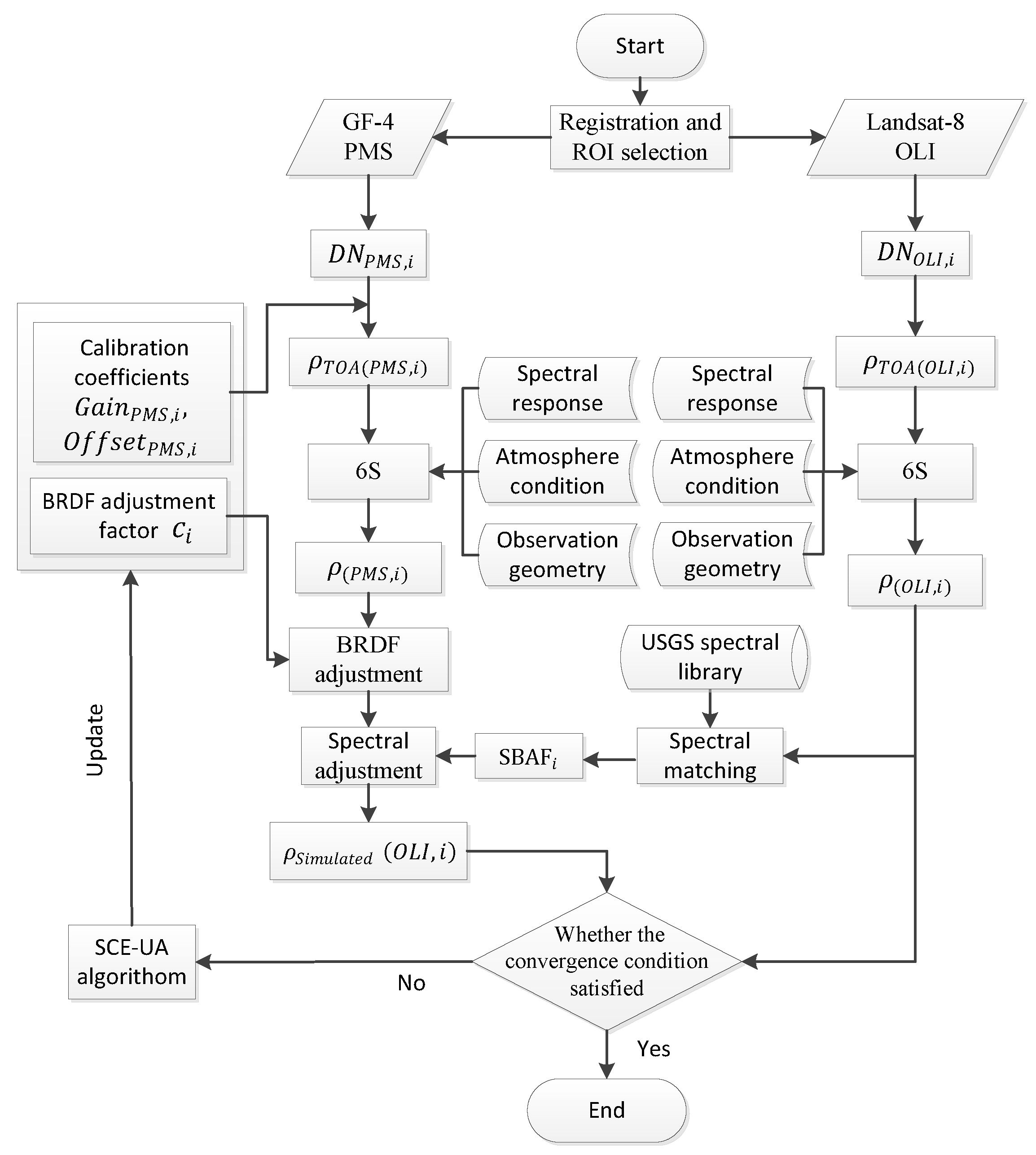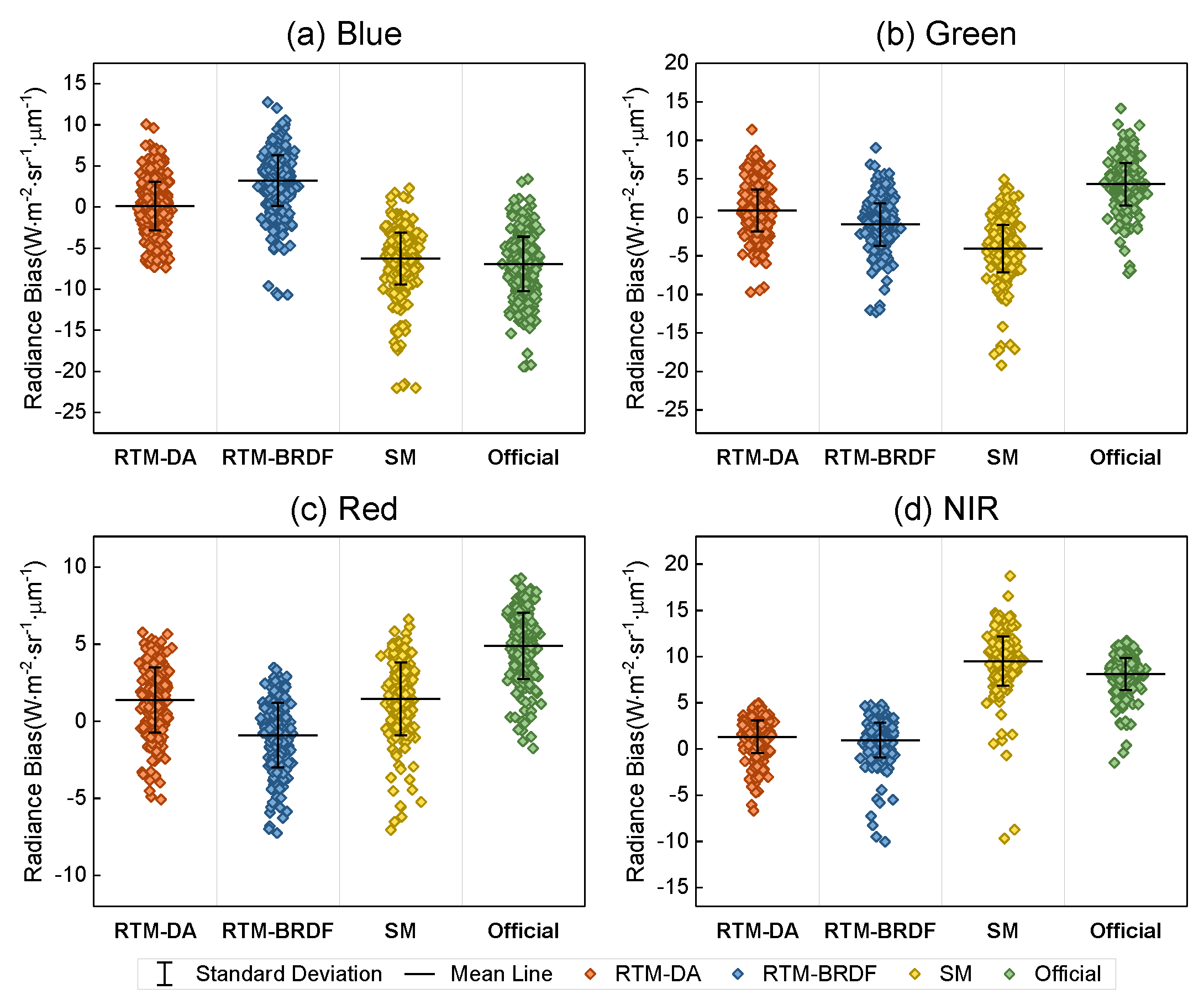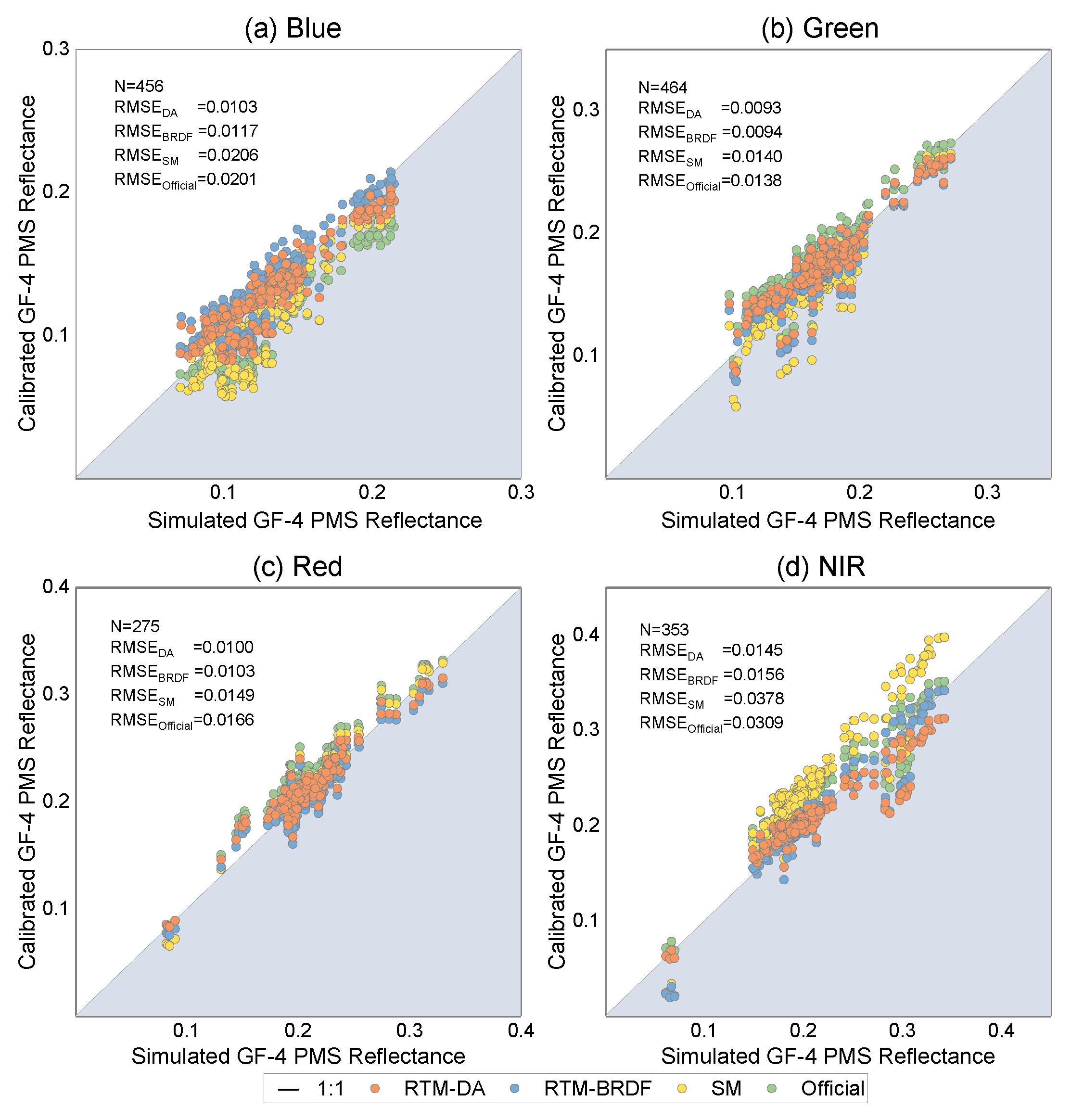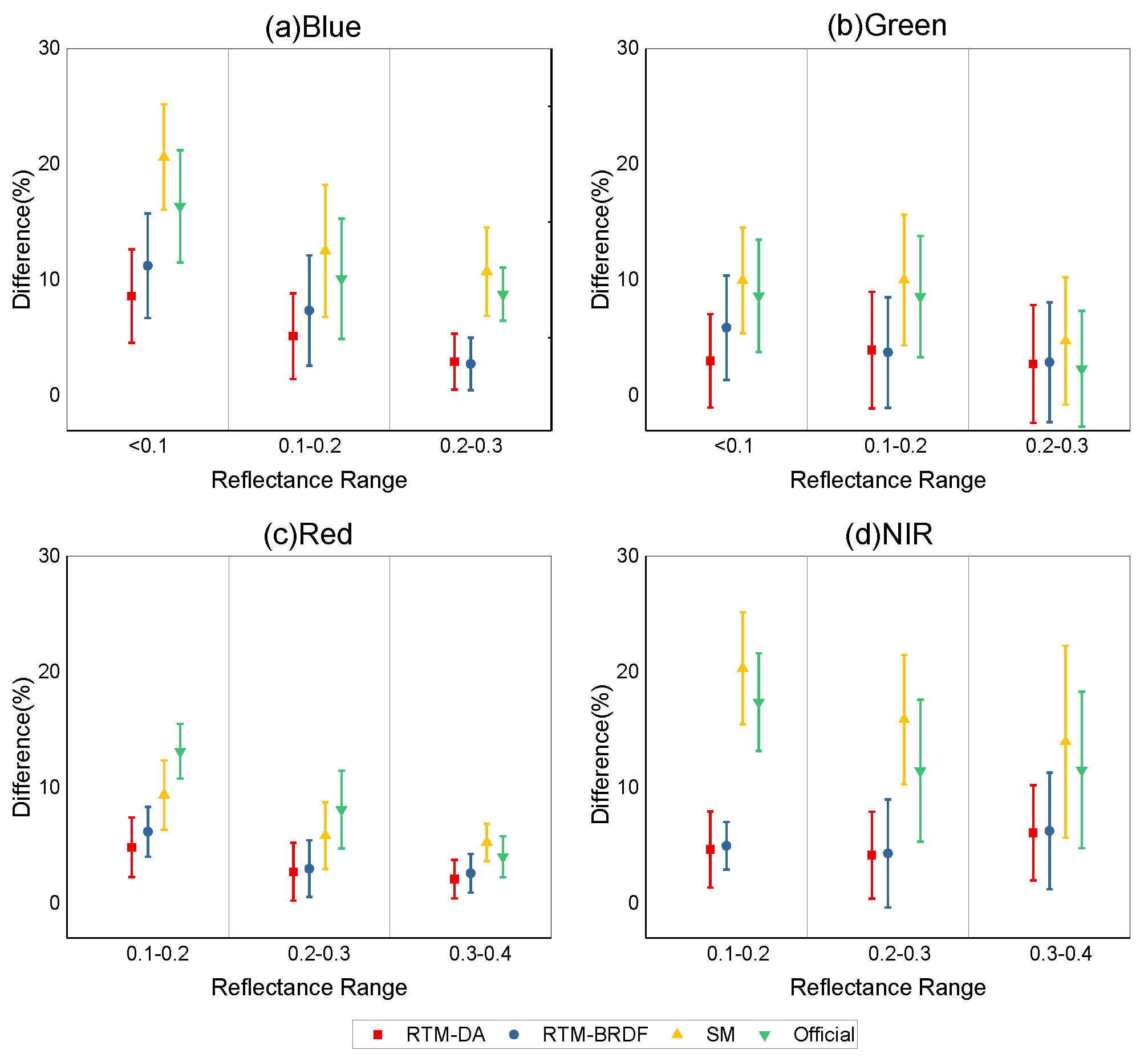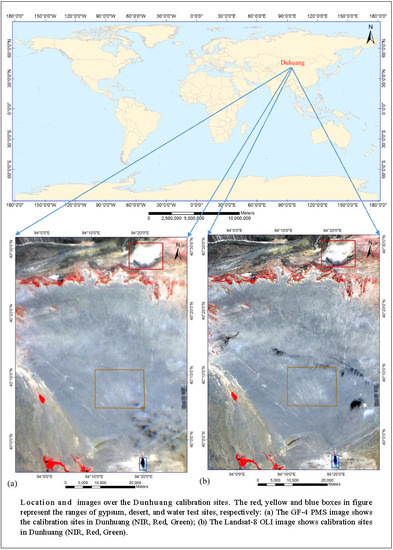3.1. TOA Reflectance Calculation
Radiometric calibration converts the digital number (DN) value into the radiance value of the corresponding pixel to eliminate the system error from the sensor. Radiance often responds linearly to the quantified standard DNs. Thus, for a given band
of GF-4 PMS data, the relationship between the TOA radiance
and the image digital number
can be written as follows:
where
is the converted radiance (
)
is the band-specific multiplicative rescaling gain and
is the band-specific additive bias. Then the radiance value can be converted into TOA reflectance by the following formula:
where
is the TOA reflectance of band
;
is the solar zenith angle and
is the distance between the sun and the earth in astronomical units;
is the average exo-atmosphere solar spectral irradiance (
), the formula to calculate the
value is as follows:
where
is the continuous exo-atmospheric solar spectral irradiance (
), obtained by the Thuilier solar spectral irradiance model [
25]; and
is the normalized spectral response function of the band
.
The TOA reflectance of the GF-4 PMS data can be obtained using Equations (1)–(3), and that of the Landsat-8 OLI data can be calculated using reflectance scaling coefficients provided by the metadata file:
where
is the band-specific multiplicative rescaling factor, and
is the band-specific addictive rescaling factor obtained from the metadata.
is the quantized standard pixel value of Landsat-8 OLI product, and
is the sun elevation angle from the metadata.
3.2. Atmospheric Correction, Spectral and BRDF Adjustment and Simulation
The disparities in surface reflectance between the GF-4 PMS and Landsat-8 OLI are caused by three factors. These include the difference in atmospheric radiation transfer process due to satellite elevation and observation angle that leads to different atmospheric radiation transfer paths in both distance and direction; the difference in the BRDF due to the effects of viewing and illumination angles; and the different spectral responses of the two sensors.
At the Dunhuang calibration site, there is a large gap between the sensor zenith angle of GF-4 PMS (49.77°) and that of the Landsat-8 OLI (0°), as well as the sensor azimuth angle (see in
Table 2). The influence of atmosphere due to viewing angle will increase the uncertainty of cross-calibration. Moreover, the large zenith angle has a significant influence on BRDF. Therefore, in order to obtain accurate cross-calibration coefficients, problems related to the large view angle must be solved.
The incoming signal received by the satellite sensor contains reflection from the surface and reflection from the atmosphere. Assuming a standard Lambertian surface, the formula for the TOA reflectance is as follows [
26]:
where
and
are solar zenith angle and azimuth angles respectively;
and
are satellite zenith angle and azimuth angles, respectively;
is the atmospheric spherical albedo;
and
are the downward and upward transmittances;
is the reflectance from the atmosphere, and
is the surface reflectance.
According to the Equation (6) to obtain the surface reflectance, the values of the
,
and
are required. The 6S model estimates these parameters from known observation geometry, atmospheric condition, and spectral response functions. In our research, MODIS AOT data were used here to get the aerosol optical depth and aerosol type. The BDRF was considered separately in the following steps, assuming no bidirectional reflection effects during atmosphere correction. The input parameters in the 6S model for one image pair are listed in
Table 2.
The reflection from the surface of the earth under natural conditions is bidirectional; the intensity of reflected irradiance depends on the direction of incident radiance and the reflection direction, and usually described by the BRDF [
27]. The BRDF is defined as the ratio of the reflected radiance from the target surface in the directions of
and
to the incident irradiance along the directions of
and
:
where B is the BRDF;
and
stand for the solar zenith angle and azimuth angle;
and
stand for the viewing zenith angle and azimuth angle.
There are several typical BRDF models that can describe the anisotropic fractures of the surface reflection, such as the Ross- Li BRDF model [
28,
29], the Rahman BRDF model [
30], and the Staylor–Suttles BRDF model [
31]. The BRDF model is quite complex. To obtain the unknown constant coefficients in the model, MODIS BRDF products or field measurements are required, resulting labor intensive, high cost and potential errors to cross-calibration because of large differences in spatial resolution and spectral response. Thus, a BRDF adjustment factor was established to eliminate the difference in the surface reflectance between the GF-4 PMS and Landsat-8 OLI due to the differences in viewing and illumination angles. For band
, the BRDF adjustment factor
can be described as follows [
32]:
where
is the BRDF of the GF-4 PMS, and
is the BRDF of the Landsat-8 OLI;
and
are the solar zenith angle and azimuth angle of the GF-4 PMS;
and
are the viewing zenith angle and azimuth angle of the GF-4 PMS;
and
are the solar zenith angle and azimuth angle of the Landsat-8 OLI;
and
are the viewing zenith angle and azimuth angle of the Landsat-8 OLI.
The definition of the BRDF adjustment factor in Equation (7) is to describe the physical meaning of the factor which make BRDF correction using the factor reasonable. We do not calculate directly in this way. As mentioned before, BRDF model is complex and difficult to estimate duo to the requirement of extra data or measurements. Thus, we use the assimilation algorithm to obtain the optimal value of , instead of calculate the BRDF of the GF-4 PMS and the Landsat-8 OLI through complex model.
A BRDF adjustment factor was established to eliminate the BRDF effect between the GF-4 PMS and Landsat-8 OLI due to the differences in viewing and illumination angles can be estimated. Thus, the surface reflectance of GF-4 PMS image acquired from its angles can be converted to the surface reflectance observed from the illumination and viewing angles of Landsat-8 OLI image, using Equations (8) as follows:
where
represents the surface reflectance;
and
are the solar zenith angle and azimuth angle of the GF-4 PMS;
and
are the sensor zenith angle and azimuth angle of the GF-4 PMS;
and
are solar viewing zenith angle and azimuth angle of the Landsat-8 OLI;
and
are sensor zenith angle and azimuth angle of the Landsat-8 OLI. The difference between the spectral response of the target sensor and that of the reference sensor is eliminated by the SBAF. The formula of SBAF is as follows [
33]:
where
is the spectral band adjustment factor for band
;
and
are respectively the surface reflectance of GF-4 PMS and Landsat-8 OLI;
is the continuous spectral reflectance of the target, and
is the continuous exo-atmospheric solar spectral irradiance;
and
are the spectral response function of GF-4 PMS and Landsat-8 OLI, respectively; and
,
and
,
are respectively the wavelength range of GF-4 PMS and Landsat-8 OLI for specific band. Then the surface reflectance of Landsat-8 OLI can be simulated as:
The reflectance of various targets is different, as is the spectral band adjustment factor, thus, it is difficult to obtain the reflectance of each ROI through measurement or by using a hyper-spectral image. The test sites at Dunhuang however, have simple types of ground targets and corresponding reflectance curves are easily obtained from the existing USGS spectral library. The 6s model was used for atmospheric correction of Landsat-8 OLI image to get discrete surface reflectance of the ROIs. Best match spectral curves can be found in the USGS spectral library. We plugged them into the Equation (9), and then calculated the SBAF. For gypsum target, the differences between the atmospherically corrected Landsat-8 OLI reflectance and the gypsum spectral curves in the USGS spectral library are quite large. Fortunately, the CCRSDA provides the filed measured spectrum of the gypsum in Dunhuang (
http://218.247.138.119/CN/fwyyytx/zgwxdbjx/5368.shtml). The measured spectrum of gypsum matched well with the mean reflectance of Landsat-8 OLI. We used the spectrum to calculate the SBAF for gypsum case. The results of spectral matching can be seen in
Figure 5.
After the atmospheric correction by the 6S model of the GF-4 PMS images, the following formula simulates the surface reflectance of Landsat-8 OLI images:
where
is the simulated surface reflectance of a Landsat-8 OLI image; and
is the atmospherically corrected surface reflectance of a GF-4 PMS image.
3.3. The SCE-UA Algorithm
SCE-UA algorithm is a global optimization algorithm proposed by Duan in 1993 [
34]. This algorithm was originally developed for hydrological models. We applied it to cross-calibration. The idea of complex shape segmentation and mixing introduced in this algorithm improves search efficiency, computation speed, and global search ability. SCE-UA is not sensitive to the initial values of the optimization parameters, thus avoiding excessive reliance on prior knowledge during optimization process and solves the problems caused by missing initial parameter values [
35]. Research shows that SCE-UA can converge to the global optimal solution efficiently due to its fast convergence speed and good stability [
36]. Although SCE-UA algorithm has many parameters, most can take default values [
37]. The objective function used in our research is as follows:
where
is the simulated surface reflectance of a Landsat-8 OLI image; and
is the atmospherically corrected surface reflectance of a Landsat-8 OLI image.
To ensure the feasibility of the optimization algorithm and the reliability of the results, for each ROI, SCE_UA algorithm runs independently 100 times. The initial values of the optimized parameters are random values within a defined range. The optimization process ends when one of the following three conditions is encountered: (1) the CV of the continuous five optimal values of objective function is less than 0.001; (2) the objective function is calculated more than 10,000 times; (3) The value of an optimized parameter shrinks to a predetermined range. If the optimization process ends in the first case, the optimization was successful, the radiometric calibration coefficients and BRDF adjustment factors corresponding to the minimum objective function values are the optimal results. If otherwise, the optimization process has failed. In this study, the success rate was 100%.



